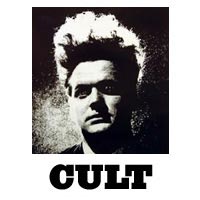 |
Part 1 |
Most cult films cut across many film genres (science fiction, horror, melodrama, etc.), although some film genres are also more prone to being cultish, such as the horror or sci-fi genres. Teen comedies are also more often rated as cult films, such as American Graffiti (1973), (National Lampoon's) Animal House (1978), Fast Times at Ridgemont High (1982), and Dazed and Confused (1993), with quotable lines of dialogue, and memorable characters and scenes. A sampling of the wide range of film genres (and sub-genres) covered by cult films includes:
Many cult films feature or effectively showcase the performance of newcomers or other unknown talented actors/actresses. Sometimes, they were revolutionary, brilliant films 'before their time' (i.e., Fantasia (1940)) and not bound by the conventions of their day. Most often, obscure and cheesy cult films are made by maverick, highly individualistic film-makers with low-budget resources and little commercial marketing. And cult films are rarely, if ever, sequels, since then they would have attained mainstream appeal and widespread success. Some directors/producers are more prone to making cult films, such as Roger Corman, John Waters, Ed Wood, Quentin Tarantino, the Coen Brothers, and David Lynch, especially early in their careers, because of their individualistic perspective and style, although they can often make a conventional 'mainstream' film too (such as David Lynch's The Straight Story (1999)). More about Cult Films: Many cult films fared poorly at the box office when first shown, but then achieved cult-film status, developing an enduring loyalty and following among fans over time, often through word-of-mouth recommendations. Cult movie worshippers persuasively argue about the merits of their choices, without regard for standard newspaper or movie reviews from critics. There's no hard-and-fast rule or checklist to gauge what makes a cult film. A cult film is often designated as such "in the eye of the beholder" without fufilling any definition. It's often a matter of opinion. One viewer's cult film may not be judged the same by another viewer. They elicit a fiery and intense passion in devoted fans, and may cause cultists to enthusiastically champion and become devoted to these films, leading to audience participation, fan club membership, and repetitive viewings and showings at repertory cinemas. Cult films have tremendous followings with certain groups, e.g., college campuses, 'midnight movie' crowds, independent film lovers, etc. The first 'official' midnight movie was Alexandro Jodorosky's strange El Topo (1970, Mex.) (aka The Mole) - a mystical 'spaghetti western' about a black-clad rogue gunfighter on a quest to defeat the 'four masters of the gun.' It premiered at midnight in a rundown NYC theatre (on lower Eighth Avenue) and ran seven nights a week for many months. The concept of long-playing, taboo-breaking, eccentric midnight movies designed to appeal to urban film fans was thereby born.
One of the biggest, best-known cult films was not intended to become so popular. It was a low-budget, government 'documentary' propaganda film from the mid-30s created to exploit or dramatize the dangers of marijuana use and demon weed - Reefer Madness (1936). However, Tod Browning's grotesque Freaks (1932), was deliberately advertised as "the strangest...most startling human story ever screened," and had alternate titles including Forbidden Love, The Monster Show, and Nature's Mistakes. It used real-life dwarfs, pinheads, and other human freaks (portraying sideshow circus performers) to present a jolting story of revenge. When first released, Crouching Tiger, Hidden Dragon (2000) and Almost Famous (2000) were almost instantly pronounced as cult films, but as time progressed, they didn't really fit the category. They were highly-acclaimed, award-winning films that were prominently shown in the mainstream, and it had been too early to judge them as cult films. The media often labels an unusual film as a 'cult film' when it really shouldn't. It takes time for a film to reach cult status. Camp films are cult-type films, but they are often poorly made or ludicrous, yet still enjoyable and appreciated. Cult films follow no rules or pattern - some cult films are popular only among certain limited groups of audiences or friends. Music-Based Cult Films:
The first of two other quintessential rock musical cult films included the transgender The Rocky Horror Picture Show (1975) - notable for inspiring the craze of interactive 'midnight movie' screenings. The iconic film was essentially a trashy tale set in a mysterious Gothic castle with kinky extraterrestrial Transylvanian transvestites, two stranded young people (including a mostly underwear-clad Susan Sarandon), and a mad scientist. Fans of the film would line up wearing costumes and bearing props to be unleashed during the midnight showings. The second was a rebellious teenage musical comedy titled Rock 'N' Roll High School (1979) that featured a rock band named The Ramones. Perry Henzell's urban-crime drama The Harder They Come (1973) with musical star Jimmy Cliff, featured a reggae soundtrack and a seamy look at poverty and crime in Jamaica. Well-Regarded Cult Films: A number of cult films are well-regarded, such as Frank Capra's
Frank Darabont's subversive, allegorical, and life-affirming
prison story about two life-sentenced prisoners, A visually rich Philip-Marlowe style detective film, director
Ridley Scott's Conversely, some of the most praised films have pornographic
origins, such as the ground-breaking Behind the Green Door (1972) due
to its star Marilyn Chambers appearing in her first adult role (she was a
former All-American Girl and Ivory Snow detergent model). Also in the early 70s during the height of a sexual revolution, the X-rated Deep Throat (1972) became one of the most influential (and successful) porn films of all time, attended by middle-class whites - it featured an unlikely plot about a sexually-dissatisfied young woman (Linda Lovelace) with a misplaced sex organ who required 'deep throat' fellatio for fulfillment. |